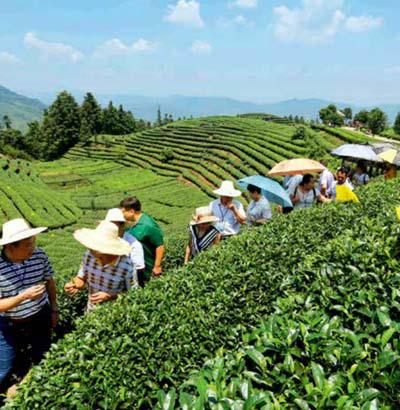A New Day in Rural China
2018-11-26byLuYilong
by Lu Yilong
After four decades of reform and opening up, Chinas rural areas have undergone tremendous changes. In the past, huge numbers of rural Chinese residents struggled just to meet food and clothing needs, but now the majority of rural areas have nearly achieved status as moderately prosperous societies. Per capita annual disposable income of Chinas rural residents increased from 134 yuan in 1978 to 13,432 yuan in 2017, multiplying by over 100 in just 40 years.
Nevertheless, Chinas rural areas still face some difficulties on the long road to modernization. Poverty remains a problem. Despite the impressive overall development of rural China, regional imbalances continue to glare across the countrys vast rural areas, and some remote mountainous areas with harsh natural conditions are still plagued by poverty. Furthermore, population migration has resulted in the “hollowing out” of rural areas. Many working-age rural residents venture to cities seeking employment as migrant workers, leaving only the elderly and children behind in the villages.
These problems evidence that rural development still has a long way to go to truly achieve socialist modernization with Chinese characteristics. In this context, China introduced a new rural vitalization strategy with an eye on developing rural areas with thriving businesses, pleasant living environments, strong social etiquette and civility, effective governance, widespread prosperity and accelerated agricultural and rural modernization.
Reform-driven Agricultural Transformation
To realize agricultural modernization, China needs to enhance efficiency and yields of the agricultural economy through technological innovation. Enhancing the efficiency of the agricultural economy means strengthening overall agricultural productivity, achieving a constant increase in agricultural output, consolidating agricultures position in the national economy and increasing agricultures contribution to national economic growth. Enhancing the yields of the agricultural economy has been shown to increase farmers incomes and expand the social and economic benefits of agricultural production.
Efforts to enhance the efficiency and yields of the agricultural economy should be driven by reform. In this new era, Chinas agricultural reform cannot be implemented according to any standardized mode. It can only be accomplished through diversified means which align with the actual conditions of specific regions. For instance, Caojiafang Village on the southwestern outskirt of Beijing adopted a reform roadmap that goes above and beyond traditional agriculture. Following the development concept stressing that“lucid waters and lush mountains are invaluable assets,” the village banned coal mining and focused its resources on developing rural tourism. This policy enabled it to transform disadvantageous conditions such as remote location in deep mountains and sparse arable land into sharp advantages. By integrating rural tourism with traditional farming and animal husbandry, the village has not only created more jobs for local residents, but also increased their incomes. Today, increasing numbers of villagers are staying to work in their hometown rather than seeking jobs in cities. Its rural vitalization practices have helped Caojiafang integrate environmental protection with thriving businesses and pro sperous lives.
Alongside implementation of the rural vitalization strategy, various regions in China are exploring paths to achieve agricultural modernization. To realize agricultural modernization, many industrialized countries relied on capital-intensive and technology-intensive measures to enhance agricultural productivity. Chinas agricultural modernization not only eyes economic objectives, but also aims to advance social progress. Any advancement of agricultural modernization should protect the interests of farmers and enable them to share the fruits of modernization in a fair way.

Of course, Chinas agricultural modernization cannot be accomplished overnight and requires a gradual process of reform and relevant supporting measures. From the macro perspective, a socioeconomic environment and institutional system supporting and encouraging agricultural reform will gradually take shape and improve. From the micro perspective, measures should be taken to mobilize grassroots communities and farmers to actively seek innovation and advance agricultural reform.
Integrated RuralUrban Development
By revitalizing its rural areas, China aims to ensure continuity of rural society and solidify rural values while developing rural society against a backdrop of modernization. As China moves toward modernization, the countryside remains an integral piece of its social structure. For this reason, continuity of rural society is particularly important.
Maintaining continuity of rural society doesnt mean leaving the countryside unchanged. Amid Chinas social transformation and economic modernization, the development of its rural areas should also advance with the times. In essence, rural modernization requires constant adjustment and alteration of lifestyles and production modes in rural areas according to new situations and conditions of social and economic development. Successful work should enable rural dwellers to coordinate and integrate with modern society.
Agricultural modernization differs significantly from rural urbanization. Indeed, urbanization can play a role in propelling rural modernization. Rural development can draw on past urbanization and modernization experience as references, but rural modernization should avoid transforming rural areas into cities.
Rural modernization should focus on creating a new landscape of integrated development of urban and rural areas through constantly coordinating and improving rural-urban relations, prompting agricultural growth with industrial growth, and stimulating rural development with urban development. Such a mechanism to ensure coordinated development of urban and rural areas will facilitate reasonable allocation and utilization of rural and urban resources, enabling both farmers and urbanites to benefit from integrated rural-urban development.
To achieve rural vitalization, the Chinese government will constantly strengthen support for the development of agriculture, farmers and rural areas. A series of policies and institutional innovations to support and benefit farmers will produce positive results. For instance, targeted poverty alleviation policies will help eliminate rural poverty and merge rural areas into moderately prosperous society. As rural modernization accelerates, confidence in rural development will be reinforced, and Chinas rural areas will take on a whole new look.